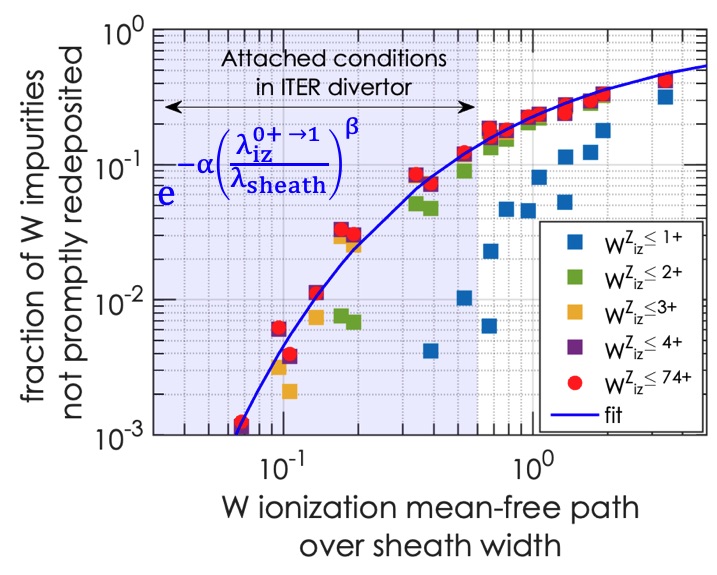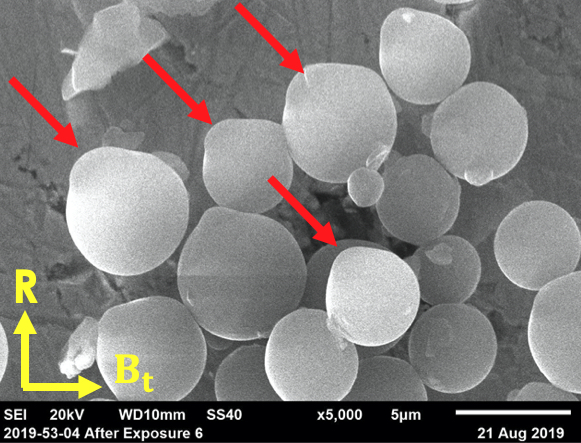Speaker
Description
Fundamental mechanisms governing the prompt redeposition of tungsten impurities sputtered in tokamak divertors have been identified and analyzed to enable quantitative estimations and in-situ monitoring of the net erosion and lifetime of tungsten divertor plasma-facing components in ITER [1]. The net erosion of tungsten divertor PFCs is primarily determined by the prompt redeposition of tungsten impurities, which is very large in the high-density partially attached divertor plasma conditions expected in ITER operational divertor scenarios. Near the divertor targets, the width of the electric sheath is of the order of several main ion Larmor radii due to the magnetic field lines intersecting the material surfaces at grazing incidence, and a vast majority of tungsten impurities sputtered from divertor PFCs are thus ionized multiple times within the sheath region. The complex interplay between the successive ionizations of tungsten impurities sputtered from divertor PFCs and the sheath electric field is shown to ultimately govern the prompt redeposition of tungsten in the divertor region (fig. 1).

Consequently, the fraction of sputtered tungsten impurities which do not promptly redeposit and contribute to the net erosion of tungsten PFCs mainly depends on the ratio of the vertical ionization mean-free path of tungsten neutrals over the sheath width. A new scaling law quantifying the prompt redeposition of high-Z impurities in divertor was obtained (fig. 1). This new scaling law significantly differs from the scaling law conventionally used for low-Z impurities [2], since effects of the sheath electric field are much stronger on trajectories of high-Z impurities than on trajectories of low-Z impurities, due to the larger mass of high-Z impurities. Following from this new scaling law, tungsten prompt redeposition is shown to be predominantly governed by the tungsten ionization rates and the width of the sheath.
Furthermore, the net erosion of tungsten divertor PFCs can only be directly monitored through spectroscopic measurements of the emission of tungsten impurities in charge states 4+, 5+ or higher near the divertor targets [1]. The fraction of tungsten impurities which do not promptly redeposit corresponds to the fraction of tungsten impurities which are ionized outside of the sheath region into the higher charge states 4+ and 5+, as a consequence of the decrease of the tungsten ionization rate when the charge state increases. In contrast, the fraction of sputtered tungsten impurities ionized into the charge state 1+, 2+ and 3+ varies moderately with the divertor plasma conditions considered here and is therefore weakly correlated to the fraction of promptly redeposited tungsten impurities.
Besides, S/XB coefficients (number of ionization events per photon) for high‐Z impurities like tungsten are significantly reduced in high‐density divertor plasma conditions (fig. 2) when sputtered impurities are ionized within the sheath region, where electrons are repelled by the sheath electric field. The modification of the electron distribution in the sheath region must be taken into account to accurately estimate the ionization and emission rates and derive the S/XB coefficients used to determine the flux of impurities from divertor PFCs [3].

Reliable predictive modeling of the net erosion of tungsten divertor PFCs requires first- principles estimations of the critical physics parameters (tungsten ionization rates and sheath width) controlling tungsten prompt redeposition, and an experimental assessment of the validity of those parameters. New ground, metastable, and some excited state ionization rate coefficients for tungsten have been calculated using non-perturbative methods, with a range of possible scaling results that allow data for all of the excited states to be evaluated. New excitation and ionization data for neutral tungsten shows that the majority of the ionization at sheath temperatures and density conditions is due to excited state ionization. High wavelength resolution observations of neutral tungsten spectral line in the UV range in the DIII-D divertor support the benchmarking of the new dataset.
In parallel, dedicated experiments have been conducted in the DIII-D divertor to assess the modeling of tungsten prompt redeposition in divertor. The ratio of the net erosion rate of tungsten samples of different sizes exposed to the same attached divertor plasma conditions is only function of the fraction of tungsten promptly redeposited on each sample when the size of the tungsten samples is comparable to the characteristic distance of the prompt redeposition of tungsten (several mms). Ratios of the net erosion rate of millimeters size tungsten samples experimentally measured in the DIII-D divertor are well reproduced with a reduced model of tungsten prompt redeposition for a variety of attached divertor plasma conditions [4], and thus provide a robust benchmark for predictive models of tungsten prompt redeposition and net erosion in ITER.
Similarly, an experimental assessment of the sheath width has been conducted in DIII-D by measuring the angle of incidence of main plasma ions impinging on divertor targets, which is a function of the sheath width, from the erosion of spherical micrometers dusts (fig. 3) and from the impurity deposition pattern in micro-engineered trenches. Resulting estimations of the sheath width are in agreement with kinetic simulations of the electric sheath in the divertor.

This work was supported in part by the US Department of Energy under DE-SC0018423, DE-FG02-95ER54309, DE-FC02-04ER54698, DE-SC0019308 and DE-AC02-09CH11466.
[1] J. Guterl et al. “Predictive modeling of tungsten net erosion in divertor” in preparation
[2] G. Fussman et al. 1995 Proc. 15th IAEA Int. Conf. (Seville) vol 2 p.143 (1995)
[3] J. Guterl, et al. Contributions to Plasma Physics (2019)
[4] J. Guterl, et al. Plasma Physics and Controlled Fusion 61.12 (2019)
| Affiliation | General Atomics |
|---|---|
| Country or International Organization | United States |
